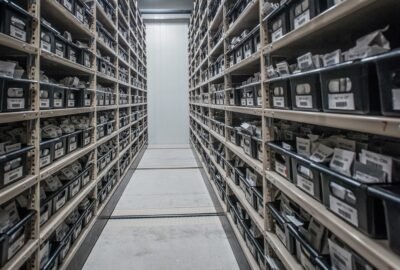Report: Establishing a National Gene Bank for Poultry Pathogens in Iraq

Dr. Majed Hamed Al Saegh / poultry pathologist / Australia
- Introduction
The poultry industry in Iraq is a vital sector for food security and economic stability. However, it faces persistent challenges due to disease outbreaks, antimicrobial resistance, and vaccine mismatches with local pathogen strains. Establishing a National Gene Bank for Poultry Pathogens is essential to address these issues, enabling advancements in diagnostics, vaccine development, and pathogen surveillance. This report outlines the requirements, steps, and benefits of creating such a facility in Iraq.
- Objectives
Preservation: Create a repository for genetic material from poultry pathogens prevalent in Iraq.
Characterisation: Facilitate the genetic and phenotypic characterisation of pathogens.
Research and Development: Support the development of diagnostics and vaccines tailored to local needs.
Surveillance: Strengthen national disease monitoring and control programs.
- Legal and Ethical Framework
National Policies:
Coordinate with the Ministry of Agriculture, Ministry of Health, and academic institutions to establish regulatory frameworks.
Develop protocols aligned with national biosafety and biosecurity laws.
International Standards:
Adhere to OIE (World Organisation for Animal Health) and FAO guidelines.
Ensure compliance with the Nagoya Protocol on Access and Benefit-sharing of Genetic Resources.
- Infrastructure Requirements
4.1 Physical Facilities
Laboratories:
Diagnostic laboratories for pathogen isolation and characterisation.
Molecular biology laboratories for DNA/RNA extraction, PCR, and sequencing.
Storage Units:
Cryopreservation facilities (-80°C freezers, liquid nitrogen tanks) for long-term storage.
Biosecurity Systems:
Biosafety levels (BSL-2 and BSL-3) depending on the risk group of pathogens.
Secure access systems for pathogen tracking and containment.
4.2 Equipment
Diagnostic tools: Incubators, microscopes, biosafety cabinets.
Molecular biology tools: PCR machines, spectrophotometers, and electrophoresis units.
Cryopreservation tools: Freezers and liquid nitrogen storage systems.
Data storage: Secure servers for digital recordkeeping and bioinformatics.
- Human Resource Development
Personnel:
Veterinary microbiologists, molecular biologists, and bioinformatics specialists.
Laboratory technicians trained in pathogen handling and preservation.
Capacity Building:
Collaborate with international organisations like FAO and OIE for training programs.
Establish academic partnerships for knowledge exchange and skill development.
- Sample Collection and Processing
6.1 Sources of Samples
Poultry farms, abattoirs, live bird markets, and veterinary clinics.
Surveillance programs targeting disease outbreaks and endemic pathogens.
6.2 Collection and Transport
Use standardised sample collection kits and transport media to ensure viability.
Label samples with metadata (e.g., date, location, host species).

6.3 Pathogen Isolation
Employ established protocols for bacterial and viral isolation.
Use selective media and culture methods for pathogen growth and identification.
6.4 Characterisation
Phenotypic Methods:
Biochemical tests, Gram staining, and haemagglutination assays.
Genotypic Methods:
PCR for pathogen identification and sequencing for genetic analysis.
Antigenic Analysis:
Protein profiling using SDS-PAGE and Western blotting.
- Genetic Material Handling
7.1 Isolation and Storage
Extract high-quality DNA/RNA using validated protocols.
Store nucleic acids in cryogenic facilities with duplicate backups in separate locations.
7.2 Data Management
Use secure databases for genetic and metadata storage.
Integrate data with global repositories (e.g., NCBI, EMBL).
- Data Management System
Develop a centralised database to record pathogen characteristics, genetic data, and metadata.
Implement bioinformatics tools for data analysis (e.g., sequence alignment, phylogenetic analysis).
Establish data-sharing policies to facilitate research collaborations while ensuring ethical use.
- Funding and Partnerships
9.1 Funding Sources
National budget allocations for agricultural development.
Grants from international organisations (FAO, WHO, OIE).
Public-private partnerships with poultry and pharmaceutical industries.
9.2 Partnerships
Collaborate with regional and international research centres.
Engage universities and NGOs for technical and operational support.
- Monitoring and Quality Control
Regularly test the viability and integrity of preserved genetic material.
Conduct audits to ensure compliance with biosafety and biosecurity standards.
Publish annual reports detailing the gene bank’s activities and achievements.
- Utilisation and Outreach
11.1 Research and Development
Facilitate access to genetic material for diagnostics and vaccine development.
Support research on antimicrobial resistance and pathogen evolution.
11.2 Stakeholder Engagement
Conduct awareness programs for veterinarians, farmers, and researchers.
Publish findings in scientific journals and participate in international conferences.
- Expected Outcomes
Comprehensive Repository: A well-documented repository of genetic material from poultry pathogens in Iraq.
Enhanced Diagnostics: Improved diagnostic tools tailored to local strains.
Vaccine Development: Locally adapted vaccines to reduce disease burden.
Strengthened Surveillance: Better monitoring and control of poultry diseases.
- Conclusion
Establishing a National Gene Bank for Poultry Pathogens in Iraq is a strategic initiative to enhance the country’s capacity in diagnostics, vaccine development, and disease surveillance. By leveraging existing knowledge, international collaborations, and phased development, Iraq can address the challenges faced by its poultry industry and contribute to global efforts in veterinary science.



